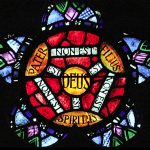But Jesus answered them, “You are wrong, because you know neither the Scriptures nor the power of God. For in the resurrection, they neither marry nor are given in marriage”
As a Catholic speaker, I’m privileged to meet young adults grappling with profound questions about identity, love, and their place in the Church. One encounter remains etched in my heart. After a talk, a young man named Sean approached me, his eyes reflecting both courage and uncertainty.
“Can I ask you something personal?” he said. “I met a guy at school, and we’ve become really close. We talk every day, hang out constantly. He’s kind, smart, funny, athletic—just incredible. I can’t stop thinking about him, and I’m starting to wonder if I’m gay. I’m scared. Am I still welcome in the Church with these thoughts?”
Sean’s vulnerability was a gift, a window into a heart seeking truth. “Sean,” I replied, “thank you for trusting me. From what you’ve shared, it’s not clear if this is same-sex attraction or simply admiration for a friend who inspires you. I get it. Ever since I can remember I was attracted to some men. The way you just described your friend, what’s not to be attracted too? I also have friends who are smart, kind, funny, and (I add) brave, courageous, and self-giving. I’m attracted to them because they raise the bar and challenge me to be a better man in so many ways.
“But let’s address your bigger question: you absolutely belong in the Church. You are a beloved child of God, and nothing can change that.”
Rooted in God’s Love
Your identity as God’s child is the cornerstone of who you are. No matter your struggles, attractions, or past, you are created for intimate communion with Jesus Christ. He invites you to “seek first His kingdom and His righteousness, and all these things will be given to you” (Mt. 6:33). Run to Jesus with your questions, doubts, and fears. He knows your heart—He crafted it. Through prayer, Scripture, and the sacraments, He’ll guide you to the truth of who He is and who you are.
Sean’s question reflects a struggle many young Catholics face: navigating attractions in a culture that offers confusing answers. To find clarity, I turned to St. John Paul II’s Theology of the Body, a treasure of Catholic teaching that unveils God’s plan for human love and identity. In a poignant talk on November 11th, 1981, delivered five months after surviving an assassination attempt on the Feast of Our Lady of Fatima, John Paul II reflected on Jesus’ dialogue with the Sadducees, who denied the resurrection (Mt. 22:23–33). This passage, part of what JPII titled “Christ’s Appeal to the Resurrection,” offers profound insight into our deepest desires.
The same day Sadducees came to him, who say that there is no resurrection; and they asked him a question, saying, “Teacher, Moses said, ‘If a man dies, having no children, his brother must marry the widow, and raise up children for his brother.’ Now there were seven brothers among us; the first married and died, and having no children left his wife to his brother. So too the second and third, down to the seventh. After them all, the woman died. In the resurrection, therefore, to which of the seven will she be the wife? For they all had her.”
But Jesus answered them, “You are wrong, because you know neither the Scriptures nor the power of God. For in the resurrection, they neither marry nor are given in marriage, but are like angels in heaven. And as for the resurrection of the dead, have you not read what was said to you by God, ‘I am the God of Abraham, and the God of Isaac, and the God of Jacob’? He is not the God of the dead, but of the living.” And when the crowd heard it, they were astonished at his teaching. (Mt. 22:23-33)
The Resurrection Reveals Our Destiny
Here Jesus unveils two truths. First, earthly marriage is a signpost to a greater reality: the “marriage of the Lamb” (Rev. 19:7), where we’re united with Christ in eternal communion. St. John Paul II describes this as the “spousal meaning of the body,” where our human relationships—rooted in love and self-gift—mirror God’s desire to be “one flesh” with us in the Eucharist. Our longing for connection isn’t random; it’s a divine spark, pointing to union with God. When we misdirect this infinite desire toward finite things—people, pleasure, or validation—we experience confusion and emptiness. The world shouts, “Follow your feelings!” but Jesus who knows you says, “Aim your heart, passions and desires, at heaven.”
Second, Jesus calls us to trust in the “power of God.” He didn’t come to manage sin but to transform hearts with grace that transcends our fallen nature. Every one of us is a sinner, and our desires, shaped by a broken world, need healing. The Catechism of the Catholic Church teaches that same-sex attraction, like any disordered desire, isn’t part of God’s original design but a result of humanity’s fall (CCC 2357). Yet, those who experience it “must be accepted with respect, compassion, and sensitivity” (CCC 2358). The path to wholeness is through the narrow gate and rooting our identity in Christ, who makes all things new (Rev. 21:5).
The Bridegroom’s Self-Giving Love
St. John Paul II ties this to Ephesians 5:25–32, where Christ is the Bridegroom who loves the Church by giving Himself fully. This spousal love reveals that all of us—male and female—are called to be the “bride” of Christ, united in Him (Gal. 3:28). St. John’s Gospel proclaims, “God is love, and he who abides in love abides in God” (1 Jn. 4:16). In the Eucharist, we encounter Christ’s self-giving love, as He offers His body and blood “for you” (Lk. 22:19–20). This is our deepest identity: we are made to love and be loved by God, eternally.
Young adults today navigate a culture that often equates identity with attractions or feelings. Social media and pop culture amplify this, suggesting that your desires define you. But the Church offers a liberating truth: you are not your attractions—you are a child of God, created for holiness. Healing comes through grace, not sheer willpower. Chastity—living love according to God’s plan—is a challenge for everyone, but it’s possible through Christ, who strengthens us (Phil. 4:13). To believe our weaknesses outweigh God’s grace is to underestimate the power of the Cross.
Living Courageously in Truth
To young Catholics like Sean, I say: don’t let the world steal the treasure of God’s truth. Love “rejoices in the truth” (1 Cor. 13:6). The Church isn’t here to condemn but to journey with you toward holiness. Here are practical steps to live this truth:
Embrace the Sacraments: Attend Mass and receive the Eucharist, where Christ meets you with transforming love. Confession is a safe space to bring your struggles and find mercy.
Temptation is an Invitation to Pray: Spend time in Adoration or with Scripture, like Matthew 6:33 or Psalm 139. Tell Jesus everything—the doubts, the fears, the hopes. He listens.
Seek Holy Community: Surround yourself with friends who share your faith and challenge you to grow in virtue. Join a parish group or Catholic young adult ministry. Use Claymore, Milites Christi as your blueprint.
Explore Church Teaching: Listen to the “Become Who You Are” Podcast and read Theology of the Body, the Catechism, Scripture, and the lives of the saints. Understanding God’s plan, along with His Grace, empowers you to live it.
Find Guidance: A priest, spiritual director, a Claymore Disciple, or trusted mentor can offer personalized wisdom as you navigate questions about identity and attraction.
The Church needs your heart, your gifts, and your courage to make love beautiful—human, Christian, and rooted in Christ. Saints like St. Augustine, who wrestled with his desires, and St. Mary Magdalene, who found freedom in Jesus, show us that transformation is possible. You’re not alone on this journey.
A Call to Bold Faith
Sean’s question reflects a universal ache: to be known, loved, and welcomed. The Church is your home, and Christ is your Bridegroom. Be bold, even when the world’s voices drown out the truth. As St. John Paul II told young people, “Do not be afraid of the love that places clear demands on you. These demands make your love true” (Letter to Youth, 1985).
Take action! This week, spend 15 minutes in Adoration and pray with Matthew 6:33, asking, “Jesus, who am I to You?” Journal your thoughts. Then, connect with a Claymore Disciple, friend, or priest, to share your journey—you’re stronger together.
Reflection Questions:
- How does being a beloved child of God shape your view of yourself?
- How can the Eucharist help you align your desires with God’s plan?
- Who can you lean on to live the Church’s teaching with courage and joy?
Author’s Note: Download the Claymore, Milites Christi Blueprint here! Claymore is a discipleship movement for courageous individuals, especially young men, committed to reclaiming their freedom and territory for Christ, by fostering a culture of life, liberty, and authentic love.
Photo by Brian Kyed on Unsplash

















